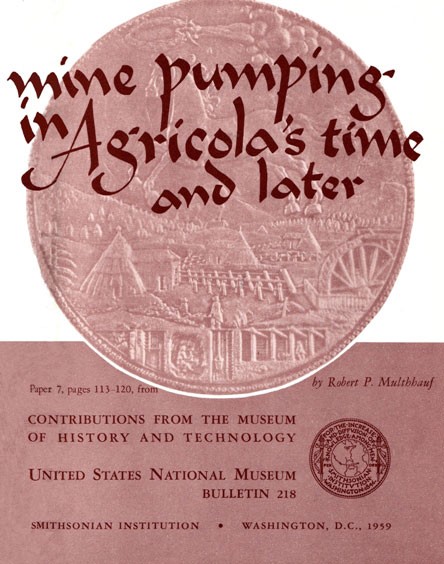
The Project Gutenberg EBook of Mine Pumping in Agricola's Time and Later, by Robert P. Multhauf This eBook is for the use of anyone anywhere at no cost and with almost no restrictions whatsoever. You may copy it, give it away or re-use it under the terms of the Project Gutenberg License included with this eBook or online at www.gutenberg.org Title: Mine Pumping in Agricola's Time and Later Author: Robert P. Multhauf Release Date: January 20, 2010 [EBook #31024] Language: English Character set encoding: ISO-8859-1 *** START OF THIS PROJECT GUTENBERG EBOOK MINE PUMPING IN AGRICOLA'S TIME *** Produced by Chris Curnow, Joseph Cooper, Stephanie Eason, and the Online Distributed Proofreading Team at https://www.pgdp.net.

Contributions from
The Museum of History and Technology:
Paper 7
Mine Pumping in
Agricola’s Time and Later
Robert P. Multhauf
[Pg 114]
By Robert P. Multhauf
Coins are a source of information much used by historians. Elaborately detailed mining landscapes on 16th-century German coins in the National Museum, discovered by the curator of numismatics and brought to the author’s attention, led to this study of early mine-pumping devices.
The Author: Robert P. Multhauf is curator of Science and Technology, Museum of History and Technology, in the Smithsonian Institution’s United States National Museum.
The habit of heavy reliance on a single source for the substance of the history of Medieval and Renaissance mining techniques in Europe has led to a rather drastic over-simplification of that history, a condition which persists tenaciously in the recent accounts of Parsons, Wolf, and Bromehead.[1] Our preoccupation with Agricola, who has been well known to the English-language public since the Hoovers’ translation of 1912, seems to have inhibited the investigation of the development of the machines he describes so elegantly. More seriously, the opinion that mining techniques remained essentially the same for a century or two beyond his time appears to have hardened into a conviction.[2]
The history of the technology of mining, as distinguished from metallurgy, is largely a history of mechanization, and that mechanization has until the last century consisted principally in the development of what Agricola calls tractoriae—hauling machines. That hauling machines of some complexity, Archimedian screws and a kind of noria, were used by the Romans for dewatering mines has been known for some time. Evidence of the survival of this technology beyond the fall of Rome remains to be found, and it is generally agreed that mining activity declined through the first millenium. The revival and extension of mining in the central European areas of German settlement is thought to have occurred from the 10th century, with an intensive development of the region known to Agricola (Erzgebirge) in the 13th century.[3]
This revival appears to have paralleled in general the political and cultural revival, but, as in any mining region, the exhaustion of easily workable surface deposits marked a critical point, when the necessity of deeper mining led to the construction of supported tunnels and the introduction of machinery for removing ores and water from deep mines. On the basis of revisions of capital structure and mining law which he regards as inspired by the financial necessities of deep mining, Bechtel dates this development from the mid-14th century.[4] The mid-14th century situation is confused by the occurrence of the Black Death, which reduced mining activity drastically, and the events of which Bechtel speaks have been put as much as a century later.[5] In any case, the development of deep-mining methods had clearly made considerable progress in nonferrous mines when the De re metallica was written, in 1556.
[Pg 115]
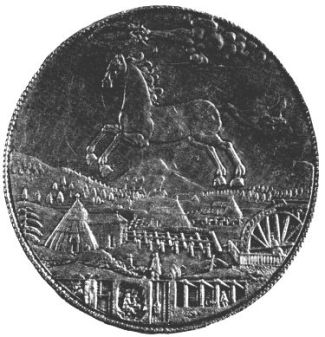
Figure 1.—Brunswick Silver 3½ Taler, Johann Friedrich, 1677. (U. S. National Museum, Paul A. Straub coll.; Smithsonian photo 43334-C.)
Mine-Pumping Machinery Illustrated By Brunswick Multiple Talers
These large silver coins weighing up to 15 ounces were first issued in 1574 in Brunswick by Duke Julius (1568-1589) of the Wolfenbuttel line. Their historical background is rather unusual and interesting.
In 1570 the Duke decided to increase the output of his silver mines in the Harz and arranged for the opening of three new mines. In order to insure the retention of a portion of this increased silver output under his control, the Duke decided to issue an entirely new kind of silver coin which he called “Loeser,” meaning redeemer. These were larger than taler-size pieces, and were struck in denominations from 1¼ to 16 talers. The Duke ordered that each of his subjects was to purchase one of these large coins, the size of the coin to be acquired depending on the individual’s wealth. The owners were not allowed to use these pieces in everyday trade, but could pawn them in case of dire need. They were expected to produce them at any time upon demand. Thus a means of hoarding, a “treasure piece,” was created, and the risk of draining the country’s wealth through replacement of good, full-weight silver coins with imported base currency was to some extent limited. At the same time, the Duke had a considerable sum of money at his disposal in case of emergency.
Similar Loesers were issued up to 1688 by different rulers of Brunswick. Some of the later issues are commemorative in character and might have served for presentation purposes. The workmanship of the majority is exquisite. They portray personages real and ideal and ornate coats of arms, in addition to the elaborate mining landscapes shown here. The U. S. National Museum is fortunate in having a number of examples through the generosity of Mr. Paul A. Straub.
For calling my attention to these coins, and for other invaluable assistance, I am indebted to the former curator of the numismatic collections of the U. S. National Museum, the late Stuart Mosher, and to the present curator, Dr. V. Clain-Stefanelli.
Figure 1 shows an overshot waterwheel driving through Stangenkunsten pumps in three separate shafts, each covered by the typical conical shaft house. It is possible that these shaft houses also cover horse whims used to operate bucket hoists such as that shown in the lower center. A house with three chimneys in the background may be the smelter. The horse over whose head the Deity holds a wreath is a symbol of Luneberg.
For a detailed description of the mechanical equipment of this era we are largely indebted to Agricola. He classifies hauling machines into four types; the ordinary bucket windlass, the piston (suction) pump, the chain of dippers, and the rag and chain pump. Although the first three had been known in antiquity, and the last perhaps a century before his time,[6] their[Pg 116] use in mining would appear to date from the mid-14th century or later. His is not an historical account, and one who attempts to compare it with others of contemporary or later times encounters a difficulty in his use of descriptive Latin names rather than the common German names used by most others. English and German editors have interpreted them as follows:[7]
| Latin | English | German |
| bulga | water bucket | Wasserkubel, Kehrrad |
| orbiculis | suction pump | Pumpe |
| situlis | chain of dippers | Kannen (werke), Bulgenkunst[8] |
| machina, quae pilis aquas hauriut | rag and chain pump | Heinzenkunst, Taschenkunst[9] |
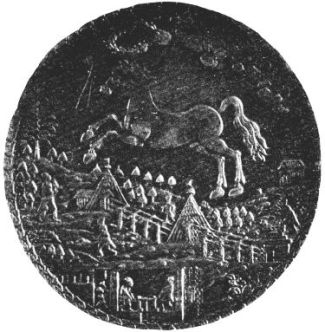
Figure 2.—Brunswick Silver 1½ Taler, Ernst August, 1688. (U. S. National Museum, Paul A. Straub coll.; Smithsonian photo 43334-A.)
Figure 2 shows two shaft-houses covering pumps driven by Stangenkunsten. The source of power, hidden by the curious “log cabin” at the right, was probably a waterwheel. I have not found evidence that the Stangenkunst was used to operate bucket hoists, as appears to be the case here. It will be noticed that the above and below ground portions of these illustrations do not correlate precisely. This coin, like the others, shows miners doing various things familiar from Agricola—divining, digging, carrying, and operating windlasses.
Figure 3 exhibits the principal advantage of the Stangenkunst, in its utilization to connect a waterwheel located in a valley stream to driven machinery on the mountain some distance above. The lute-playing girl (Lautenspielerin) refers to the Lautental mine. A Stangenkunst (fig. 7) existed here as recently as 1930.
The mines shown in figures 1-3 are in the Harz region.
Figures 4 and 5 show the St. Anna mine in the Erzgebirge, near Freiberg, as illustrated on a medal in the Brunswick museum. Prominent in figure 4 is an aqueduct, one function of which is to supply a waterwheel in the house below, which in turn delivers power through the Stangenkunst to two open shafts. The reverse (fig. 5), an unusually fine view of the inner workings of a mine, shows, above ground, a typical horse whim driving a bucket windlass. Below ground is shown a crank-driven piston pump typical of those driven by Stangenkunst. In this case, however, it is driven by an underground vertical treadmill.
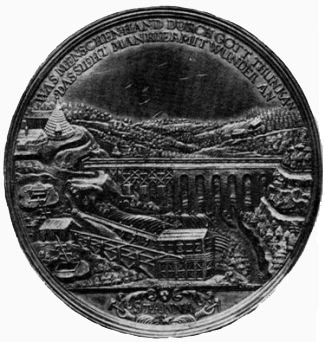
Figure 3.—Brunswick Silver 4 Taler, Ernst August, 1685. (U. S. National Museum, Paul A. Straub coll.; Smithsonian photo 43334-A.)
[Pg 117]
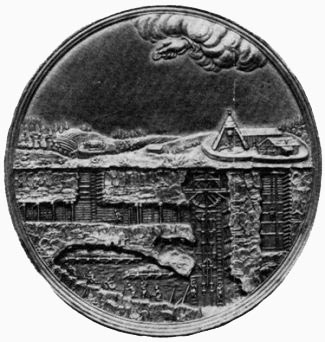
Figure 4.—Medal, 1690, Showing St. Anna Mine, near Freiberg. (Photo courtesy of Stadtisches Museum, Braunschweig.)
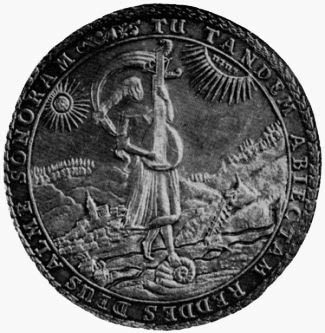
Figure 5.—Reverse of Medal shown in figure 4. (Photo courtesy of Stadtisches Museum, Braunschweig.)
The resemblance of the German term for bag (Bulge) to the Latin term for bucket (bulga) instead of the Latin term for bag (canalis), and the presence of buckets (Kübeln), bags (Bulgen), pockets (Taschen), or cans (Kannen) as components of three of Agricola’s four categories of hauling machines are reasons enough for the apparent superfluity of German names, if not for his decision to avoid the use of German names. But it should also be noted that the names sometimes refer to a pump and its prime mover considered as a single machine. Such is the case with the Kehrrad, a bucket windlass driven by a reversible waterwheel which Agricola describes as his largest hauling machine.[10]
Agricola describes 23 hauling devices of these four types, the diversity resulting generally from the application of three types of prime movers, men, horses, and waterwheels, and in the endowment of each in turn with a mechanical advantage in the form of gearing.[11] Although he does not specify clearly the relative importance of the various pumps, the majority (13) use man as the prime mover. He speaks of the advantages of some, noting that the horse whim has a power two and a half times that of the man windlass, and emphasizing the even greater power available in flowing water “when a running stream can be diverted to a mine.” The most powerful machine then in use for deep mines appears to have been the horse-powered rag and chain pump.
Such, then, were the important mining machines of this early period of deep mining, according to the leading authority. But did they continue, as has been claimed, to be the only important machines of the subsequent century? G. E. Lohneyss,[12] writing a little over a half century after the publication of De re metallica, declared:
The old miners [alten Bergleute] had Heintzen, Kerratt, Bulgenkunst, Taschen-kunst, Pumpen, with which one lifted water with cans on pulleys or with a treadmill; and they devised and constructed these in which the poor people moved like cattle and wore themselves out. At that time they had powerful machines (Kunst) using swift water, although it cost much to erect and maintain them, and was very dangerous since an iron chain of a Bulgenkunst alone often weighed 200 centner [over 10 tons] and more.
[Pg 118]But today’s artisan [jetzigen Künstler] far surpasses the old ... since we have in the present time invented many other mining machines; such as the Stangenkunst mit dem krummen Zapffen, which raises water at small cost over 100 Lachter [562 feet].
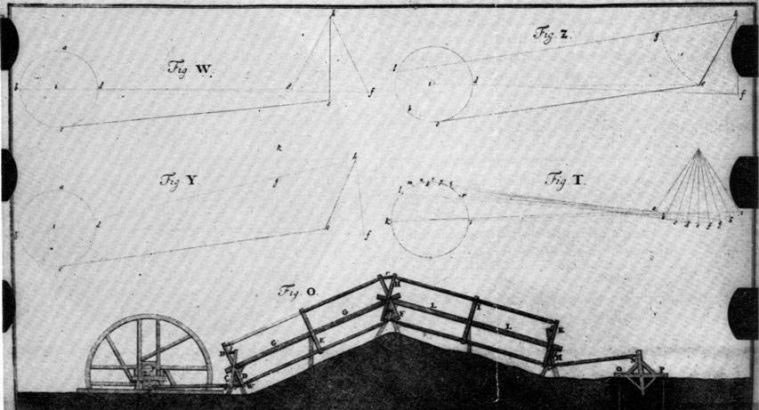
Figure 6.—Stangenkunst, Showing Driving Wheel, Feldkunst, and Kunstkreuz. From H. Calvör (see footnote 15).
The Stangenkunst, which can be roughly translated as “rod work with crank,” was a piston pump driven through a crank and rods by a prime mover located at a distant point. Agricola describes a crank-driven piston pump, calling it a new machine invented ten years earlier.[13] But it is not driven bya distant prime mover. Like his other water-powered hauling machines it can only be used “when a running stream can be diverted to a mine.” So far as we can determine from internal evidence, Agricola did not know the Stangenkunst.
Although the full development of the Stangenkunst came later, it was apparently introduced in Agricola’s time. Its introduction to the Erzgebirge has been put as early as 1550.[14] According to another authority it was introduced to the Harz in 1565 by one Heinrich Eschenbach of Meissen.[15] Its significance is only made clear to us by later authorities. As shown in figure 3 it was adapted to the utilization of a distant stream, through the Feldstangen, an extended horizontal series of reciprocating rods, and the Kunstkreuz (fig. 6), a lever in the shape of a cross for changing at right angles the direction of power transmission. These improvements may have been almost contemporaneous with Agricola, as Calvör[Pg 119] mentions the use of the Feldkunst, which term signified the extended rods, as having been known in 1565.
The disadvantage of moving the weight of a long extension of rods was obviated, during the 17th century, through the use of a double set of balanced rods, resembling a pantograph. At some later date the horse whim was fitted with a crank and adapted to the Stangenkunst,[16] thus permitting the establishment of a veritable power network, as suggested in figure 1.
The Freiberg mine director Martin Planer reported in 1570 the installation since 1557 of thirty-eight “Kunsten und Zeugen” in mines under his charge. That these were water-powered machines is clear from his remark that their cost was only 10 to 20 percent that of “Pferden und Knechten.”[17] It is likely that many if not most were Stangenkunsten, for mining treatises of the 17th and 18th centuries testify to the continuous extension of this mechanism.[18]
Perhaps the most striking evidence of its importance is its representation on the illustrated coinage of the 17th century. These multiple talers (figs. 1, 2, 3), happy products of the ingenious fiscal policies of the Dukes of Brunswick, picture mining activity in the 17th century no less elegantly than do the woodcuts of De re metallica a century earlier. The Stangenkunst received its most spectacular application in France, in its application to the driving of the second- and third-stage pumps in the famous waterworks at Marly (1681-88), but its real importance is better illustrated in central Europe, by the many descriptions and drawings showing its use in the mines, driving machinery as distant as a mile[19] from the source of power.
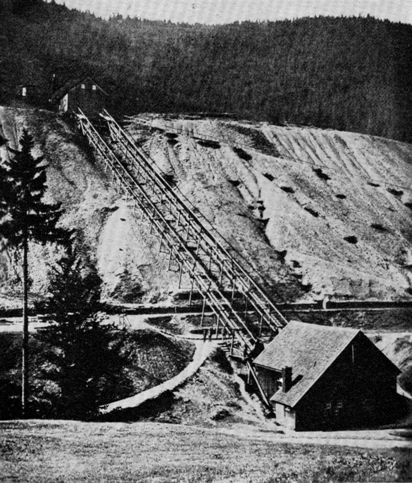
Figure 7.—Feldgestange (Stangenkunst) Near Lautental. From C. Matschoss, Technische Kulturdenkmal, Munich, 1932.
It seems, therefore, that Lohneyss’ “old miners” were those described by Agricola, and that the mine-hauling machinery used in central European mines changed in the century after him far more than has been recognized.[20] This thesis may further cast some light on other technological questions. The[Pg 120] connection between the urgency of the problem of mine drainage in England, and the invention of the steam engine, has often been suggested.[21] Perhaps the “backwardness” of Germany in steam-engine experimentation, and later in the introduction of the Newcomen engine, was to some extent due to the adequacy of existing machinery to meet the problem of mine flooding, for it is not clear that this problem existed on the continent.[22]
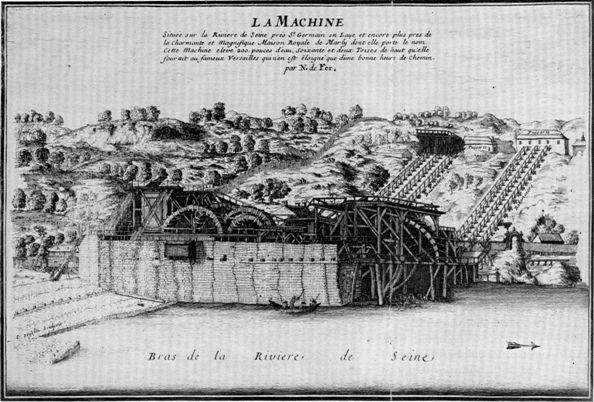
Figure 8.—The Waterworks at Marly-le-Roi, on the Seine River, Built in 1684 to Supply the Fountains at the Royal Palace at Versailles. From a print by de Fer, 1705. (Smithsonian photo 45593.)
A comparison of the techniques described by Agricola with those of a century later suggests that this was a century of significant progress in that earlier industrial revolution described by Mumford as his “Eotechnic phase,” characterized by “the diminished use of human beings as prime movers, and the separation of the production of energy from its application and immediate control.”[23]
Footnotes:
[1] W. B. Parsons, Engineers and engineering in the Renaissance, Baltimore, 1939. Abraham Wolf, A history of science, technology, and philosophy in the 16th and 17th centuries, New York, 1935; and A history of science, technology and philosophy in the eighteenth century, London, 1938. C. M. Bromehead, “Mining and quarrying to the seventeenth century,” in Charles Singer and others, A history of technology, vol. 2, Oxford, 1956.
[2] According to Parsons (op. cit., footnote 1, p. 629) the introduction of machinery worked by animals and falling water, “radical improvements” of the 15th century, fixed the development of the art “until the eighteenth, and, in some respects, even well into the nineteenth century.” Wolf in his History of science ... in the eighteenth century (p. 629, see footnote 1) agrees, saying that “apart from [the steam engine] mining methods remained [during the 18th century] essentially similar to those described in Agricola’s De re metallica.” Bromehead (op. cit., footnote 1, p. 22), in referring to the date 1673 also sees “no appreciable change in methods of mining since Agricola.”
[3] Parsons, op. cit. (footnote 1), p. 179. T. A. Rickard, Man and metals, New York, 1932, vol. 2, pp. 519-521.
[4] Heinrich Bechtel, Wirtschaftstil des deutschen Spätmittelalters, Munich, 1930, pp. 202-203. Bechtel calls this one of the most revolutionary industrial developments of the middle ages.
[5] Rickard (op. cit., footnote 3, pp. 547-554, 561) also speaks of a decline through the exhaustion of surface deposits, but dates the revival 1480-1570. He supports this conclusion by statistics on the leading mine at Rammelsberg, which was unproductive from the Black Death (1347) to 1450, and only slightly active before 1518.
[6] According to F. M. Feldhaus (Die Technik, Leipzig and Berlin, 1914, p. 833.), a manuscript illustration of this type of pump, which he calls Schöpfkolbenkette, appears in the Mariano Codex latinus 197, B. 180, dated 1438, in the Munich Hofbibliothek.
[7] Based on a comparison of the following editions of Agricola, De re metallica: Froben, Basel, 1556 (in Latin; the first edition); The Mining Magazine, London, 1912 (English translation by H. C. and L. H. Hoover); VDI, Berlin, 1928 (German translation by Carl Schiffner).
[8] The emergence of the term Kunst in German mining terminology is connected with the application of water power, especially to pumping (see Heinrich Veith, Deutsches Berg-wörterbuch, Breslau, 1870, article “Kunst”).
[9] According to Veith (op. cit., footnote 8, p. 306), B. Rössler, in his Speculum metallurgiae politissimum (Dresden, 1700, p. 41) says that the Taschenkunst (pocket-work) was used with a pipe, like the rag and chain pump, and the translator of the German (1928) edition of De re metallica also uses Heinzen and Taschen interchangeably. Calvör and others, however, seem to use Taschenkunst for the ordinary chain of dippers, which seems better suited to its literal meaning.
[10] Agricola, op. cit. (footnote 7), ed. Hoover, p. 199. His contemporary and fellow-townsman Mathesius equates the Kehrrad to the Bulgenkunst (Sarepta, p. 145, Nurnberg, 1571). According to Veith (op. cit., footnote 8, p. 286), Sebastian Münster in his Cosmographei ... (p. 381, Basel, 1558), had previously mentioned its use in the mines of Meissen; and its introduction has been put as early as 1500 by Otto Vogel (“Christopher Pohlem und seine Beziehungen zum Harzer Bergbäu,” Beiträge zur Geschichte der Technik und Industrie, 1913, vol. 5, p. 324.)
[11] Agricola, op. cit. (footnote 7), ed. Hoover, pp. 160-199.
[12] G. E. Lohneyss, Bericht von Bergwerken, 1619?, n. p., p. 3.
[13] Agricola, op. cit. (footnote 7), ed. Hoover, pp. 184-185. The crank was centuries old at this time, and had been applied to pumping earlier than the time mentioned by Agricola, although perhaps not in mining. A drawing dated 1405 shows an Archimedian screw turned by a crank (Feldhaus, op. cit., footnote 6, p. 834). The Mittelalterliche Hausbuch (ed. H. T. Bossert and W. F. Storck, Leipzig, 1912, Tafel 32), a German description of technology that appeared in 1480, shows an arrangement very like that described by Agricola, although not in mining service.
[14] O. Fritsche and A. Wagenbreth, “Die Wasserhaltungs-maschinen bei Agricola und sein Einfluss auf ihre weitere Entwicklung,” in Deutsche Akademie der Wissenschaft zu Berlin, Georgius Agricola, (East) Berlin: Akademie Verlag, 1953, p. 112.
[15] Hennig Calvör, Acta historico-chronologico-mechanica circa Metallurgiam ..., Braunschweig, 1763, pp. 36-37.
[16] I have been unable to find an early reference to this innovation, which appears in a sketch of 1784-85 illustrating Conrad Matschoss’, “Die Maschinen des deutschen Berg- und Hüttenwesens vor 100 Jahren,” Beiträge zur Geschichte der Technik und Industrie (1909), Band I, p. 7. Its introduction may be connected with the appearance of the term Rosskunst for the horse windlass, known earlier as the Göpel.
[17] “Bericht des Bergverwalters Martin Planer über den Stand des Freiberger Bergbaues im Jahre 1570,” ed. R. Wengler, Mittheilungen Freiberger Altertumsverein, 1898, vol. 35, pp. 75-83.
[18] The description of the Stangenkunst in its various modifications is one of the chief topics of the previously cited work of Calvör (footnote 15), and from his and other references it is clear that the subject was also treated extensively by such earlier writers as Lohneyss (1617) and Rössler (1700).
[19] Fritsche and Wagenbreth, op. cit. (footnote 14), p. 112.
[20] The hauling of ores, as opposed to water, seems to have remained as shown by Agricola until the end of the 17th century. In 1694, however, the famous Swedish engineer Christopher Polhem built at Falun a water-powered conveyer system which brought the ore from the point of origin in the mine to the smelter in a single operation, terminating with the automatic unloading of the buckets (Vogel, op. cit., footnote 10, p. 306).
[21] Dickinson, H. W., A short history of the steam engine, New York, n. d., p. 3.
[22] In 1673 Edward Browne visited Hungary and the Erzgebirge. His report on the trip, A brief account of some travels in diverse parts of Europe (2nd ed., London, 1685, p. 170), says little about machinery, but does not mention flooding as a serious problem. Of an 84-fathom mine called Auff der Halsbrucker, near Freiberg, he says “they are not so much troubled with water, and have very good engines to draw water out.” Yet the chain of dippers and rag and chain pump were evidently fallen into disuse, as they do not appear among the mining machines reported by Fritsche and Wagenbreth as having been described by Lohneyss (1617) or Rössler (1700); and Fritsche and Wagenbreth declare that German hydraulic machinery was able to compete with the steam engine in mine dewatering for some time into the 19th century (op. cit., footnote 14, pp. 111, 112).
[23] Lewis Mumford, Technics and civilization, New York, 1934, p. 112.
End of the Project Gutenberg EBook of Mine Pumping in Agricola's Time and
Later, by Robert P. Multhauf
*** END OF THIS PROJECT GUTENBERG EBOOK MINE PUMPING IN AGRICOLA'S TIME ***
***** This file should be named 31024-h.htm or 31024-h.zip *****
This and all associated files of various formats will be found in:
https://www.gutenberg.org/3/1/0/2/31024/
Produced by Chris Curnow, Joseph Cooper, Stephanie Eason,
and the Online Distributed Proofreading Team at
https://www.pgdp.net.
Updated editions will replace the previous one--the old editions
will be renamed.
Creating the works from public domain print editions means that no
one owns a United States copyright in these works, so the Foundation
(and you!) can copy and distribute it in the United States without
permission and without paying copyright royalties. Special rules,
set forth in the General Terms of Use part of this license, apply to
copying and distributing Project Gutenberg-tm electronic works to
protect the PROJECT GUTENBERG-tm concept and trademark. Project
Gutenberg is a registered trademark, and may not be used if you
charge for the eBooks, unless you receive specific permission. If you
do not charge anything for copies of this eBook, complying with the
rules is very easy. You may use this eBook for nearly any purpose
such as creation of derivative works, reports, performances and
research. They may be modified and printed and given away--you may do
practically ANYTHING with public domain eBooks. Redistribution is
subject to the trademark license, especially commercial
redistribution.
*** START: FULL LICENSE ***
THE FULL PROJECT GUTENBERG LICENSE
PLEASE READ THIS BEFORE YOU DISTRIBUTE OR USE THIS WORK
To protect the Project Gutenberg-tm mission of promoting the free
distribution of electronic works, by using or distributing this work
(or any other work associated in any way with the phrase "Project
Gutenberg"), you agree to comply with all the terms of the Full Project
Gutenberg-tm License (available with this file or online at
https://gutenberg.org/license).
Section 1. General Terms of Use and Redistributing Project Gutenberg-tm
electronic works
1.A. By reading or using any part of this Project Gutenberg-tm
electronic work, you indicate that you have read, understand, agree to
and accept all the terms of this license and intellectual property
(trademark/copyright) agreement. If you do not agree to abide by all
the terms of this agreement, you must cease using and return or destroy
all copies of Project Gutenberg-tm electronic works in your possession.
If you paid a fee for obtaining a copy of or access to a Project
Gutenberg-tm electronic work and you do not agree to be bound by the
terms of this agreement, you may obtain a refund from the person or
entity to whom you paid the fee as set forth in paragraph 1.E.8.
1.B. "Project Gutenberg" is a registered trademark. It may only be
used on or associated in any way with an electronic work by people who
agree to be bound by the terms of this agreement. There are a few
things that you can do with most Project Gutenberg-tm electronic works
even without complying with the full terms of this agreement. See
paragraph 1.C below. There are a lot of things you can do with Project
Gutenberg-tm electronic works if you follow the terms of this agreement
and help preserve free future access to Project Gutenberg-tm electronic
works. See paragraph 1.E below.
1.C. The Project Gutenberg Literary Archive Foundation ("the Foundation"
or PGLAF), owns a compilation copyright in the collection of Project
Gutenberg-tm electronic works. Nearly all the individual works in the
collection are in the public domain in the United States. If an
individual work is in the public domain in the United States and you are
located in the United States, we do not claim a right to prevent you from
copying, distributing, performing, displaying or creating derivative
works based on the work as long as all references to Project Gutenberg
are removed. Of course, we hope that you will support the Project
Gutenberg-tm mission of promoting free access to electronic works by
freely sharing Project Gutenberg-tm works in compliance with the terms of
this agreement for keeping the Project Gutenberg-tm name associated with
the work. You can easily comply with the terms of this agreement by
keeping this work in the same format with its attached full Project
Gutenberg-tm License when you share it without charge with others.
1.D. The copyright laws of the place where you are located also govern
what you can do with this work. Copyright laws in most countries are in
a constant state of change. If you are outside the United States, check
the laws of your country in addition to the terms of this agreement
before downloading, copying, displaying, performing, distributing or
creating derivative works based on this work or any other Project
Gutenberg-tm work. The Foundation makes no representations concerning
the copyright status of any work in any country outside the United
States.
1.E. Unless you have removed all references to Project Gutenberg:
1.E.1. The following sentence, with active links to, or other immediate
access to, the full Project Gutenberg-tm License must appear prominently
whenever any copy of a Project Gutenberg-tm work (any work on which the
phrase "Project Gutenberg" appears, or with which the phrase "Project
Gutenberg" is associated) is accessed, displayed, performed, viewed,
copied or distributed:
This eBook is for the use of anyone anywhere at no cost and with
almost no restrictions whatsoever. You may copy it, give it away or
re-use it under the terms of the Project Gutenberg License included
with this eBook or online at www.gutenberg.org
1.E.2. If an individual Project Gutenberg-tm electronic work is derived
from the public domain (does not contain a notice indicating that it is
posted with permission of the copyright holder), the work can be copied
and distributed to anyone in the United States without paying any fees
or charges. If you are redistributing or providing access to a work
with the phrase "Project Gutenberg" associated with or appearing on the
work, you must comply either with the requirements of paragraphs 1.E.1
through 1.E.7 or obtain permission for the use of the work and the
Project Gutenberg-tm trademark as set forth in paragraphs 1.E.8 or
1.E.9.
1.E.3. If an individual Project Gutenberg-tm electronic work is posted
with the permission of the copyright holder, your use and distribution
must comply with both paragraphs 1.E.1 through 1.E.7 and any additional
terms imposed by the copyright holder. Additional terms will be linked
to the Project Gutenberg-tm License for all works posted with the
permission of the copyright holder found at the beginning of this work.
1.E.4. Do not unlink or detach or remove the full Project Gutenberg-tm
License terms from this work, or any files containing a part of this
work or any other work associated with Project Gutenberg-tm.
1.E.5. Do not copy, display, perform, distribute or redistribute this
electronic work, or any part of this electronic work, without
prominently displaying the sentence set forth in paragraph 1.E.1 with
active links or immediate access to the full terms of the Project
Gutenberg-tm License.
1.E.6. You may convert to and distribute this work in any binary,
compressed, marked up, nonproprietary or proprietary form, including any
word processing or hypertext form. However, if you provide access to or
distribute copies of a Project Gutenberg-tm work in a format other than
"Plain Vanilla ASCII" or other format used in the official version
posted on the official Project Gutenberg-tm web site (www.gutenberg.org),
you must, at no additional cost, fee or expense to the user, provide a
copy, a means of exporting a copy, or a means of obtaining a copy upon
request, of the work in its original "Plain Vanilla ASCII" or other
form. Any alternate format must include the full Project Gutenberg-tm
License as specified in paragraph 1.E.1.
1.E.7. Do not charge a fee for access to, viewing, displaying,
performing, copying or distributing any Project Gutenberg-tm works
unless you comply with paragraph 1.E.8 or 1.E.9.
1.E.8. You may charge a reasonable fee for copies of or providing
access to or distributing Project Gutenberg-tm electronic works provided
that
- You pay a royalty fee of 20% of the gross profits you derive from
the use of Project Gutenberg-tm works calculated using the method
you already use to calculate your applicable taxes. The fee is
owed to the owner of the Project Gutenberg-tm trademark, but he
has agreed to donate royalties under this paragraph to the
Project Gutenberg Literary Archive Foundation. Royalty payments
must be paid within 60 days following each date on which you
prepare (or are legally required to prepare) your periodic tax
returns. Royalty payments should be clearly marked as such and
sent to the Project Gutenberg Literary Archive Foundation at the
address specified in Section 4, "Information about donations to
the Project Gutenberg Literary Archive Foundation."
- You provide a full refund of any money paid by a user who notifies
you in writing (or by e-mail) within 30 days of receipt that s/he
does not agree to the terms of the full Project Gutenberg-tm
License. You must require such a user to return or
destroy all copies of the works possessed in a physical medium
and discontinue all use of and all access to other copies of
Project Gutenberg-tm works.
- You provide, in accordance with paragraph 1.F.3, a full refund of any
money paid for a work or a replacement copy, if a defect in the
electronic work is discovered and reported to you within 90 days
of receipt of the work.
- You comply with all other terms of this agreement for free
distribution of Project Gutenberg-tm works.
1.E.9. If you wish to charge a fee or distribute a Project Gutenberg-tm
electronic work or group of works on different terms than are set
forth in this agreement, you must obtain permission in writing from
both the Project Gutenberg Literary Archive Foundation and Michael
Hart, the owner of the Project Gutenberg-tm trademark. Contact the
Foundation as set forth in Section 3 below.
1.F.
1.F.1. Project Gutenberg volunteers and employees expend considerable
effort to identify, do copyright research on, transcribe and proofread
public domain works in creating the Project Gutenberg-tm
collection. Despite these efforts, Project Gutenberg-tm electronic
works, and the medium on which they may be stored, may contain
"Defects," such as, but not limited to, incomplete, inaccurate or
corrupt data, transcription errors, a copyright or other intellectual
property infringement, a defective or damaged disk or other medium, a
computer virus, or computer codes that damage or cannot be read by
your equipment.
1.F.2. LIMITED WARRANTY, DISCLAIMER OF DAMAGES - Except for the "Right
of Replacement or Refund" described in paragraph 1.F.3, the Project
Gutenberg Literary Archive Foundation, the owner of the Project
Gutenberg-tm trademark, and any other party distributing a Project
Gutenberg-tm electronic work under this agreement, disclaim all
liability to you for damages, costs and expenses, including legal
fees. YOU AGREE THAT YOU HAVE NO REMEDIES FOR NEGLIGENCE, STRICT
LIABILITY, BREACH OF WARRANTY OR BREACH OF CONTRACT EXCEPT THOSE
PROVIDED IN PARAGRAPH F3. YOU AGREE THAT THE FOUNDATION, THE
TRADEMARK OWNER, AND ANY DISTRIBUTOR UNDER THIS AGREEMENT WILL NOT BE
LIABLE TO YOU FOR ACTUAL, DIRECT, INDIRECT, CONSEQUENTIAL, PUNITIVE OR
INCIDENTAL DAMAGES EVEN IF YOU GIVE NOTICE OF THE POSSIBILITY OF SUCH
DAMAGE.
1.F.3. LIMITED RIGHT OF REPLACEMENT OR REFUND - If you discover a
defect in this electronic work within 90 days of receiving it, you can
receive a refund of the money (if any) you paid for it by sending a
written explanation to the person you received the work from. If you
received the work on a physical medium, you must return the medium with
your written explanation. The person or entity that provided you with
the defective work may elect to provide a replacement copy in lieu of a
refund. If you received the work electronically, the person or entity
providing it to you may choose to give you a second opportunity to
receive the work electronically in lieu of a refund. If the second copy
is also defective, you may demand a refund in writing without further
opportunities to fix the problem.
1.F.4. Except for the limited right of replacement or refund set forth
in paragraph 1.F.3, this work is provided to you 'AS-IS' WITH NO OTHER
WARRANTIES OF ANY KIND, EXPRESS OR IMPLIED, INCLUDING BUT NOT LIMITED TO
WARRANTIES OF MERCHANTIBILITY OR FITNESS FOR ANY PURPOSE.
1.F.5. Some states do not allow disclaimers of certain implied
warranties or the exclusion or limitation of certain types of damages.
If any disclaimer or limitation set forth in this agreement violates the
law of the state applicable to this agreement, the agreement shall be
interpreted to make the maximum disclaimer or limitation permitted by
the applicable state law. The invalidity or unenforceability of any
provision of this agreement shall not void the remaining provisions.
1.F.6. INDEMNITY - You agree to indemnify and hold the Foundation, the
trademark owner, any agent or employee of the Foundation, anyone
providing copies of Project Gutenberg-tm electronic works in accordance
with this agreement, and any volunteers associated with the production,
promotion and distribution of Project Gutenberg-tm electronic works,
harmless from all liability, costs and expenses, including legal fees,
that arise directly or indirectly from any of the following which you do
or cause to occur: (a) distribution of this or any Project Gutenberg-tm
work, (b) alteration, modification, or additions or deletions to any
Project Gutenberg-tm work, and (c) any Defect you cause.
Section 2. Information about the Mission of Project Gutenberg-tm
Project Gutenberg-tm is synonymous with the free distribution of
electronic works in formats readable by the widest variety of computers
including obsolete, old, middle-aged and new computers. It exists
because of the efforts of hundreds of volunteers and donations from
people in all walks of life.
Volunteers and financial support to provide volunteers with the
assistance they need are critical to reaching Project Gutenberg-tm's
goals and ensuring that the Project Gutenberg-tm collection will
remain freely available for generations to come. In 2001, the Project
Gutenberg Literary Archive Foundation was created to provide a secure
and permanent future for Project Gutenberg-tm and future generations.
To learn more about the Project Gutenberg Literary Archive Foundation
and how your efforts and donations can help, see Sections 3 and 4
and the Foundation web page at https://www.pglaf.org.
Section 3. Information about the Project Gutenberg Literary Archive
Foundation
The Project Gutenberg Literary Archive Foundation is a non profit
501(c)(3) educational corporation organized under the laws of the
state of Mississippi and granted tax exempt status by the Internal
Revenue Service. The Foundation's EIN or federal tax identification
number is 64-6221541. Its 501(c)(3) letter is posted at
https://pglaf.org/fundraising. Contributions to the Project Gutenberg
Literary Archive Foundation are tax deductible to the full extent
permitted by U.S. federal laws and your state's laws.
The Foundation's principal office is located at 4557 Melan Dr. S.
Fairbanks, AK, 99712., but its volunteers and employees are scattered
throughout numerous locations. Its business office is located at
809 North 1500 West, Salt Lake City, UT 84116, (801) 596-1887, email
business@pglaf.org. Email contact links and up to date contact
information can be found at the Foundation's web site and official
page at https://pglaf.org
For additional contact information:
Dr. Gregory B. Newby
Chief Executive and Director
gbnewby@pglaf.org
Section 4. Information about Donations to the Project Gutenberg
Literary Archive Foundation
Project Gutenberg-tm depends upon and cannot survive without wide
spread public support and donations to carry out its mission of
increasing the number of public domain and licensed works that can be
freely distributed in machine readable form accessible by the widest
array of equipment including outdated equipment. Many small donations
($1 to $5,000) are particularly important to maintaining tax exempt
status with the IRS.
The Foundation is committed to complying with the laws regulating
charities and charitable donations in all 50 states of the United
States. Compliance requirements are not uniform and it takes a
considerable effort, much paperwork and many fees to meet and keep up
with these requirements. We do not solicit donations in locations
where we have not received written confirmation of compliance. To
SEND DONATIONS or determine the status of compliance for any
particular state visit https://pglaf.org
While we cannot and do not solicit contributions from states where we
have not met the solicitation requirements, we know of no prohibition
against accepting unsolicited donations from donors in such states who
approach us with offers to donate.
International donations are gratefully accepted, but we cannot make
any statements concerning tax treatment of donations received from
outside the United States. U.S. laws alone swamp our small staff.
Please check the Project Gutenberg Web pages for current donation
methods and addresses. Donations are accepted in a number of other
ways including including checks, online payments and credit card
donations. To donate, please visit: https://pglaf.org/donate
Section 5. General Information About Project Gutenberg-tm electronic
works.
Professor Michael S. Hart was the originator of the Project Gutenberg-tm
concept of a library of electronic works that could be freely shared
with anyone. For thirty years, he produced and distributed Project
Gutenberg-tm eBooks with only a loose network of volunteer support.
Project Gutenberg-tm eBooks are often created from several printed
editions, all of which are confirmed as Public Domain in the U.S.
unless a copyright notice is included. Thus, we do not necessarily
keep eBooks in compliance with any particular paper edition.
Most people start at our Web site which has the main PG search facility:
https://www.gutenberg.org
This Web site includes information about Project Gutenberg-tm,
including how to make donations to the Project Gutenberg Literary
Archive Foundation, how to help produce our new eBooks, and how to
subscribe to our email newsletter to hear about new eBooks.